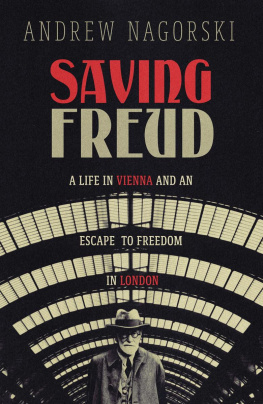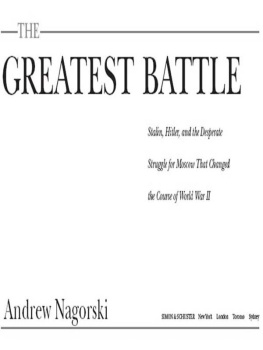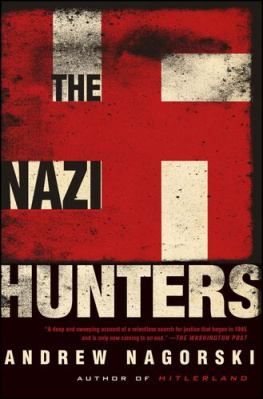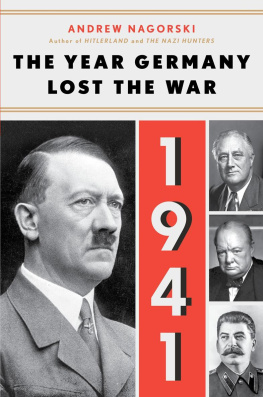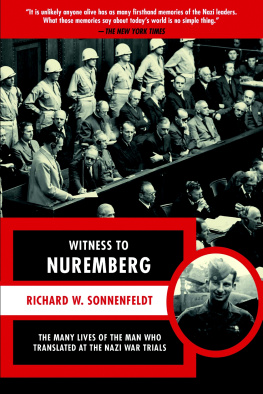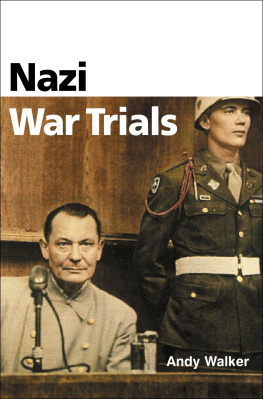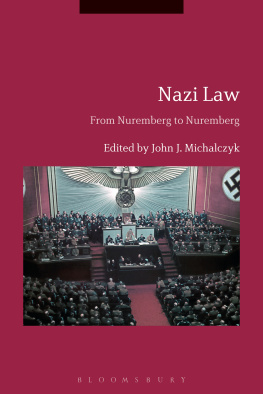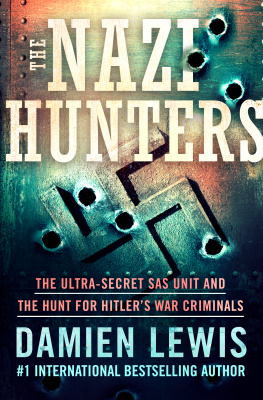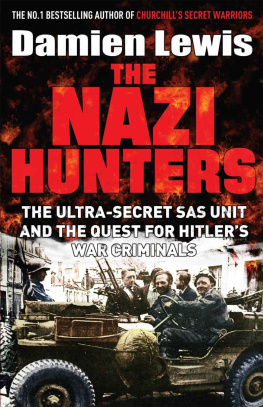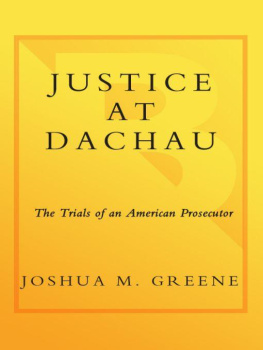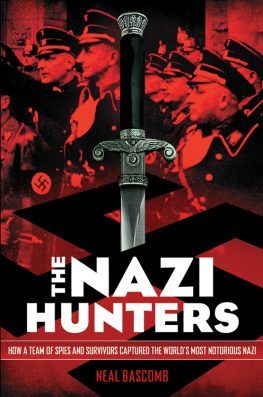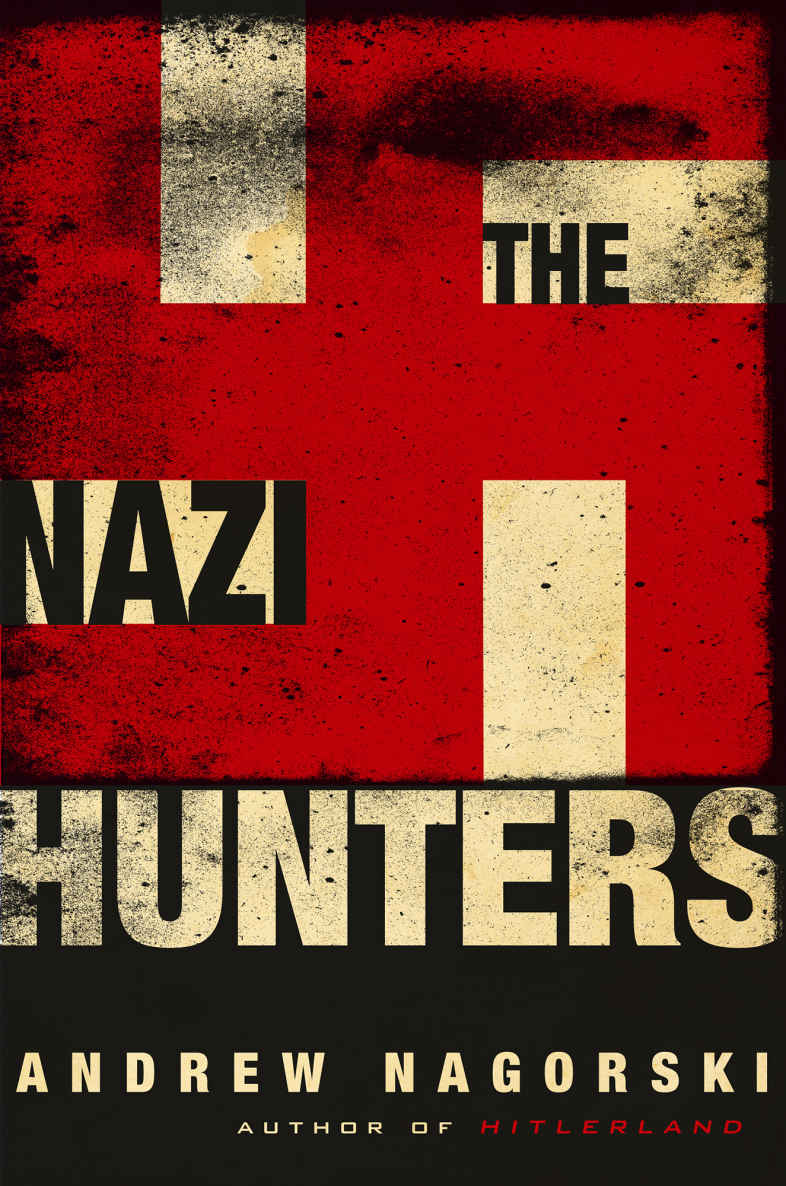Thank you for downloading this Simon & Schuster eBook.
Join our mailing list and get updates on new releases, deals, bonus content and other great books from Simon & Schuster.
C LICK H ERE T O S IGN U P
or visit us online to sign up at
eBookNews.SimonandSchuster.com
Contents
For Alex, Adam, Sonia and Eva,
And, as always,
for Krysia
Cast of Characters
THE HUNTERS:
Fritz Bauer (19031968): A German judge and prosecutor from a secular Jewish family, Bauer spent most of the Nazi era in exile in Denmark and Sweden. Returning to Germany after the war, he provided the Israelis with the key tip that led to the capture of Adolf Eichmann. In the 1960s, he orchestrated the Frankfurt Auschwitz trial.
William Denson (19131998): The U.S. Army chief prosecutor at the Dachau trials after the war, which focused on the personnel who ran the death machinery in Dachau, Mauthausen, Buchenwald, and Flossenbrg. He prosecuted 177 people, winning guilty verdicts for all of them. In the end, ninety-seven of them were hanged. But there was controversy about his handling of some of those cases.
Rafi Eitan (1926 ): The Mossad agent who was in charge of the commando unit that kidnapped Adolf Eichmann near his home in Buenos Aires on May 11, 1960.
Benjamin Ferencz (1920 ): At age twenty-seven, Ferencz was the chief prosecutor in what the Associated Press called the biggest murder trial in history: the Nuremberg trial of the commanders of the Einsatzgruppen, the special squads that conducted mass killings of Jews, Gypsies, and other civilian enemies on the Eastern Front before the killings were shifted to the gas chambers of the camps. All twenty-two defendants were convicted, and thirteen were sentenced to death. Several of the sentences were later reduced, and only four were hanged.
Tuvia Friedman (19222011): A Polish Jewish survivor of the Holocaust, Friedman first served in the security forces of the postwar Polish communist regime, seeking revenge against captured Germans and anyone else accused of helping the former occupiers. He then set up the Documentation Center in Vienna, collecting evidence to help convict SS officers and others guilty of war crimes. In 1952, he closed his center down and moved to Israel, where he continued to insist he was on the trail of Eichmann and other war criminals.
Isser Harel (19122003): The Mossad chief who succeeded in arranging the kidnapping of Eichmann in Buenos Aires in 1960 and his transport to Israel on a special El Al flight, which led to Eichmanns trial and execution in Jerusalem.
Elizabeth Holtzman (1941 ): When she became a member of Congress in 1973, the Brooklyn Democrat quickly began looking into charges that many alleged war criminals were living peacefully in the United States. As a member of the House immigration subcommittee and later its chair, she successfully pushed for the creation of the Justice Departments Office of Special Investigations (OSI) in 1979. OSI led the effort to find, denaturalize, and deport Nazi war criminals.
Beate Klarsfeld (1939 ): A risk taker par excellence, she was the more flamboyant half of the Nazi hunting German-French couple. Her father served in the Wehrmacht and she knew very little about the Third Reichs legacy until she moved to Paris to work as an au pair and met her future husband, Serge Klarsfeld. In 1968, she famously slapped West German Chancellor Kurt Georg Kiesinger, who had been a member of the Nazi Party. Along with Serge, she also tracked and confronted SS men guilty of deporting Jews and other crimes in occupied France.
Serge Klarsfeld (1935 ): Born into a family of Jews in Romania who then moved to France, he had a strong personal motive to document, publicize, and pursue top Nazis who had been responsible for the deportations and deaths of Jews in France: his father died in Auschwitz. Meticulously gathering incriminating evidence, he publicized the Nazis recordsand, like his wife, Beate, was not afraid to confront the wartime Nazis directly, ignoring the risks.
Eli Rosenbaum (1955 ): He first joined the Justice Departments Office of Special Investigations as an intern, and from 1995 to 2010 was its longest-serving director. While serving as general counsel of the World Jewish Congress in 1986, he led the campaign against former U.N. Secretary-General Kurt Waldheim during his campaign for the Austrian presidency. That led to his bitter clash with the man he had once idolized: Simon Wiesenthal.
Allan Ryan (1945 ): From 1980 to 1983, he served as the director of the Justice Departments Office of Special Investigations, leading the new unit in its early battles to identify and strip Nazi war criminals of their U.S. citizenship.
Jan Sehn (19091965): A Polish investigating judge who grew up in a family of German descent, he produced the first detailed account of the history and operation of Auschwitz. He handled the interrogation of Rudolf Hss, the camps longest serving commandant, and convinced him to write his memoirs before he was hanged in 1947. He also helped his German counterpart Fritz Bauer by providing testimony for the Frankfurt Auschwitz trial in the 1960s.
Simon Wiesenthal (19082005): Born in a small town in Galicia, he survived Mauthausen and other ordeals and became the most famous Nazi hunter, operating out of his Documentation Center in Vienna. While widely credited with tracking down several prominent war criminals, Wiesenthal was sometimes attacked for allegedly embellishing his role and accomplishments, particularly in the hunt for Eichmann. He also clashed with the World Jewish Congress during the Kurt Waldheim controversy.
Efraim Zuroff (1948 ): The founder and director of the Simon Wiesenthal Centers office in Jerusalem, Zuroff was born in Brooklyn but settled in Israel in 1970. Frequently referred to as the last Nazi hunter, he has mounted highly publicized, controversial campaigns to locate and prosecute surviving concentration camp guards.
THE HUNTED:
Klaus Barbie (19131991): Known as the Butcher of Lyon, the former Gestapo chief in that French city was responsible for thousands of deaths and personally tortured countless victims. His most prominent victims: Jean Moulin, the hero of the French Resistance, and the forty-four Jewish children who were given shelter in the tiny village of Izieuand perished in Auschwitz. The Klarsfelds tracked him to Bolivia, waging a long campaign to get him to stand trial in France. Given a life sentence in 1987, he died in prison four years later.
Martin Bormann (19001945): Hitlers personal secretary and head of the Nazi Party Chancellery, he had disappeared from Hitlers bunker in Berlin after his boss committed suicide on April 30, 1945. While there were reports that he had been killed or committed suicide almost immediately, there were also persistent rumors that he had escaped from the German capitaland even tales of sightings and shootouts in South America and Denmark. In 1972 his purported remains were found at a Berlin construction site, and DNA evidence in 1998 confirmed his identity. The conclusion was that he died on May 2, 1945.
Hermine Braunsteiner (19191999): A former guard in the Majdanek and Ravensbrck concentration camps, she was called Kobyathe Polish word for marebecause of her habit of viciously kicking women prisoners. In 1964, Simon Wiesenthal discovered that she had married an American after the war and was living in Queens, New York. He tipped off The New York Times , which ran a story that triggered a lengthy legal battle to strip her of her citizenship. Sent to West Germany, she was given a life sentence in 1981, and released for health reasons in 1996. She died in a nursing home three years later.


